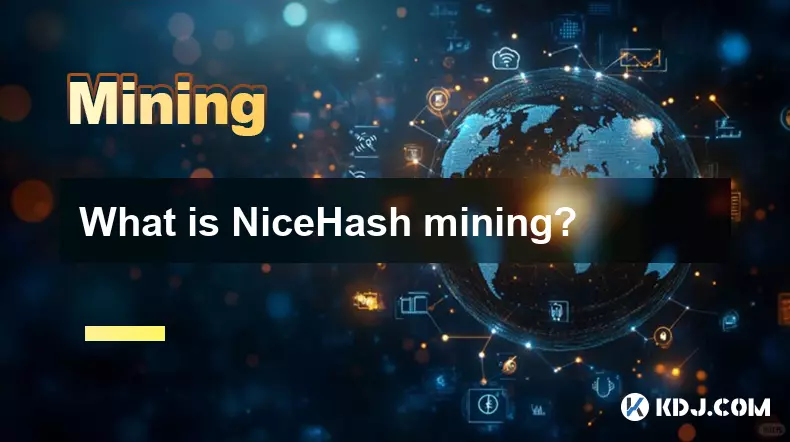-
 bitcoin
bitcoin $103094.926080 USD
3.95% -
 ethereum
ethereum $3398.208576 USD
6.43% -
 tether
tether $0.999971 USD
-0.04% -
 xrp
xrp $2.326205 USD
9.96% -
 bnb
bnb $947.145845 USD
4.46% -
 solana
solana $160.315987 USD
7.54% -
 usd-coin
usd-coin $1.000014 USD
0.01% -
 tron
tron $0.288163 USD
2.37% -
 dogecoin
dogecoin $0.164881 USD
5.50% -
 cardano
cardano $0.536519 USD
7.14% -
 hyperliquid
hyperliquid $40.526327 USD
6.62% -
 chainlink
chainlink $14.898178 USD
5.68% -
 bitcoin-cash
bitcoin-cash $483.923206 USD
4.44% -
 ethena-usde
ethena-usde $0.999280 USD
0.02% -
 stellar
stellar $0.276354 USD
6.32%
How do mining algorithms work?
Mining algorithms secure blockchains by requiring computational work to validate transactions, with different algorithms balancing decentralization, hardware resistance, and energy efficiency across networks.
Nov 06, 2025 at 04:59 am

Mining Algorithms and Their Role in Blockchain Networks
1. Mining algorithms serve as the backbone of blockchain consensus mechanisms, ensuring that transactions are verified and added to the ledger in a decentralized manner. These algorithms define how computational work is performed by network participants, often referred to as miners, to validate blocks of transactions.
2. Each algorithm sets specific mathematical challenges that miners must solve using hardware resources. The first miner to solve the puzzle broadcasts the solution to the network, where other nodes verify its correctness before appending the block to the chain.
3. The difficulty of these puzzles adjusts dynamically based on network activity, maintaining consistent block creation times regardless of how much total computing power is engaged in mining.
4. By requiring substantial computational effort, mining algorithms deter malicious actors from attempting to manipulate transaction history. Altering any single block would require re-mining not only that block but all subsequent blocks, which becomes exponentially costly.
5. Different cryptocurrencies adopt different mining algorithms to achieve varying goals such as decentralization, resistance to specialized hardware, or energy efficiency.
Common Types of Mining Algorithms
1. Proof of Work (PoW) is the most widely recognized mining algorithm, used originally by Bitcoin. It relies on hash functions like SHA-256, where miners repeatedly hash block data with a changing nonce until a result below a target threshold is found.
2. Scrypt, utilized by Litecoin, was designed to be memory-intensive rather than purely computation-heavy, aiming to prevent dominance by ASICs and promote more equitable participation using consumer-grade hardware.
3. Ethash, developed for Ethereum prior to its shift to Proof of Stake, emphasizes large dataset storage requirements, making it resistant to ASIC optimization and favoring GPU-based mining setups.
4. RandomX, adopted by Monero, switches hashing techniques frequently and leverages multiple CPU instruction types to maintain fairness across general-purpose processors while discouraging centralized mining farms.
5. Equihash, used by Zcash, relies on complex mathematical problems related to the generalized birthday problem, demanding significant RAM usage and limiting the effectiveness of dedicated mining rigs.
Hardware Evolution and Algorithm Compatibility
1. Early cryptocurrency mining could be efficiently performed using standard CPUs. As competition increased, miners transitioned to GPUs due to their parallel processing capabilities, significantly boosting hash rates for certain algorithms.
2. The rise of Application-Specific Integrated Circuits (ASICs) revolutionized mining for algorithms like SHA-256, concentrating mining power among those who could afford expensive, high-efficiency machines.
3. Some projects deliberately design algorithms to resist ASIC optimization, preserving decentralization by allowing broader access through common hardware like GPUs or CPUs.
4. Mining pools emerged as individual miners found it difficult to compete alone. Participants combine their computational resources and share rewards proportionally, increasing chances of solving blocks despite growing network difficulty.
5. Energy consumption associated with mining has led to innovations in cooling systems, renewable energy integration, and geographic relocation of mining operations to regions with cheap electricity.
Frequently Asked Questions
What determines the profitability of a mining algorithm?Profitability depends on the algorithm’s hash rate, electricity costs, hardware efficiency, network difficulty, and the market value of the mined coin. Miners often switch between coins based on real-time profitability metrics.
Can one piece of hardware mine multiple algorithms?GPUs can typically mine various algorithms, though performance varies. ASICs are hardwired for specific algorithms and cannot adapt to others, limiting their flexibility but maximizing efficiency for targeted chains.
Why do some algorithms aim to be ASIC-resistant?ASIC-resistant algorithms seek to prevent centralization by keeping mining accessible to individuals using consumer hardware, promoting a more distributed and democratic network structure.
How does an algorithm influence blockchain security?A robust mining algorithm ensures that attacking the network requires prohibitively high computational resources. This economic barrier protects against double-spending and maintains trust in transaction integrity.
Disclaimer:info@kdj.com
The information provided is not trading advice. kdj.com does not assume any responsibility for any investments made based on the information provided in this article. Cryptocurrencies are highly volatile and it is highly recommended that you invest with caution after thorough research!
If you believe that the content used on this website infringes your copyright, please contact us immediately (info@kdj.com) and we will delete it promptly.
- Unlock Crypto Rewards Daily: Your Guide to Spell Wallet, Daily Puzzles, and Earning MANA
- 2025-11-07 05:10:01
- Hyperliquid, Buybacks, and Pump.fun: Decoding the Trends
- 2025-11-07 04:55:01
- Morpho Network's DeFi Reliability Test: Service Interruption Shakes User Confidence
- 2025-11-07 05:10:01
- Bitcoin, Ethereum, and the Government Shutdown: Navigating the Uncertainty
- 2025-11-07 05:15:01
- Altcoins, Bitcoin, and Ethereum: Navigating the Crypto Winter of 2025
- 2025-11-07 05:35:01
- Stablecoin Dollar Peg Lost Value: A Wild Ride in the Crypto World
- 2025-11-07 05:30:02
Related knowledge

What is the block reward in mining?
Nov 06,2025 at 12:35am
Understanding Block Rewards in Cryptocurrency Mining1. The block reward is the incentive miners receive for successfully validating and adding a new b...

How do mining algorithms work?
Nov 06,2025 at 04:59am
Mining Algorithms and Their Role in Blockchain Networks1. Mining algorithms serve as the backbone of blockchain consensus mechanisms, ensuring that tr...

What is NiceHash mining?
Nov 06,2025 at 07:40am
NiceHash mining refers to the process of renting out computational power to individuals or organizations seeking to mine cryptocurrencies without owni...

Does an antivirus program affect mining?
Nov 05,2025 at 09:29pm
Understanding Decentralized Exchanges in the Crypto Ecosystem1. Decentralized exchanges (DEXs) operate without a central authority, allowing users to ...

What is the history of Bitcoin mining?
Nov 05,2025 at 08:15pm
Within the fast-moving world of cryptocurrency, new developments emerge daily, reshaping how investors, developers, and institutions interact with dig...

How is the energy consumption of mining justified?
Nov 05,2025 at 10:20pm
Energy Consumption in Cryptocurrency Mining1. The energy consumption associated with cryptocurrency mining has drawn significant attention from enviro...

What is the block reward in mining?
Nov 06,2025 at 12:35am
Understanding Block Rewards in Cryptocurrency Mining1. The block reward is the incentive miners receive for successfully validating and adding a new b...

How do mining algorithms work?
Nov 06,2025 at 04:59am
Mining Algorithms and Their Role in Blockchain Networks1. Mining algorithms serve as the backbone of blockchain consensus mechanisms, ensuring that tr...

What is NiceHash mining?
Nov 06,2025 at 07:40am
NiceHash mining refers to the process of renting out computational power to individuals or organizations seeking to mine cryptocurrencies without owni...

Does an antivirus program affect mining?
Nov 05,2025 at 09:29pm
Understanding Decentralized Exchanges in the Crypto Ecosystem1. Decentralized exchanges (DEXs) operate without a central authority, allowing users to ...

What is the history of Bitcoin mining?
Nov 05,2025 at 08:15pm
Within the fast-moving world of cryptocurrency, new developments emerge daily, reshaping how investors, developers, and institutions interact with dig...

How is the energy consumption of mining justified?
Nov 05,2025 at 10:20pm
Energy Consumption in Cryptocurrency Mining1. The energy consumption associated with cryptocurrency mining has drawn significant attention from enviro...
See all articles










































































